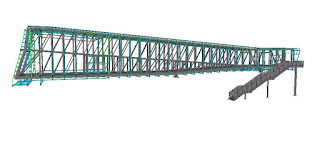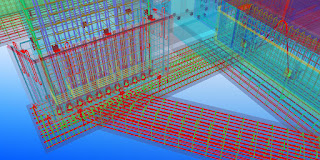Steel detailing
is a pivotal and multifarious step in the process of developing
anything made out of steel be it a basic building, modern plants,
spans, lifts, air dealing with units, and non-building structures. It
is an extremely basic process and requests intensive precision.
Structural steel detailing is an important and mandatory process in
all types of manufacturing and construction activities. The line of
process requires a number of following steps:-
-
The structural engineer and/or architect conceive an idea about a project and put it on paper in a general way. These drawings could also contain items linked to mechanical systems which pertain to the fabrication of the steel members.
-
Next in the detailing process, the steel detailer takes these design/ drawings and transforms them into meticulous diagrams for each steel piece.
-
The Detailer then produces drawings and plans for the making and erection of steel members such as beams, trusses, columns, braces, stairs and handrails, metal decking and joists etc.
With the ever-shifting market demand, the
need to stay ahead requires innovation and sustainable strategy. The
technologies used in CAD Steel
Detailing are computer- aided
design or CAD; earlier, manual drafting methods were used. The
process also involves 3D Modeling Technique which is an advanced
version of 2D drafting. 3D provides a better visualization and
insight into the project. 3D Modeling can be done with software like
X- Steel, AutoCAD and Microstation.
In steel detailing, the detailer’s
drawings covering the making of the steel pieces are called Shop
Drawings. They distinguish the exact particulars for creating every
part/bit of a structure. With steel detailing, once the steel
fabricator produces the steel members, the steel detailer steps in
again and produces the drawings for the erection of the steel members
in the field. These are called erection drawings.
It is the building site steel erector who
alludes to these illustrations in the steel enumerating process, so
as to know how and where to work with the created steel pieces.
Included in the erection drawings are dimensional plans to identify
the steel members, in addition to all work required on the site
including welding, bolting, and installing masonry anchors.
Structural Steel detailing high precision professional experts as these drawings must be able to
define and detail intricate tasks, the widespread usage of latest CAD
technologies and 3D software has improved the quality, speed, and
accuracy of structural steel detailing. It has made exact drawings in
3D format has become easy and affordable than complicated manual
detailing.
Structural Engineering Services has risen as a basic segment of open, business and mechanical
developments where steel components are overwhelming. Appropriate
from modern structures to private and shopping edifices, the
technique is broadly depended on design quick and mistake. Devoted
experts prepared in itemizing principles and CAD guarantees more
noteworthy accuracy and quicker finishing of basic steel specifying.
SteelConstruction Detailing understand
the essentials of healthy and perfect environment for living. We
provide all sorts of Steel Structural Engineering Services ;
we understand client’s need and prioritize the work accordingly. We
work on various sectors, from Structure to Architecture and
Mechanical to Electrical.

































